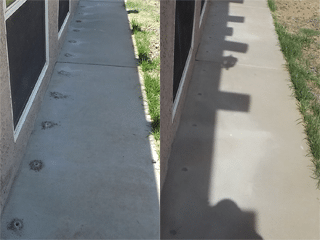If you need to schedule a Termite Treatment immediately, please CLICK HERE

Subterranean Termites
Subterranean termites require a moist environment and a constant supply of food (wood) to thrive. Unfortunately, the Phoenix Metropolitan area, with millions of wood-framed structures and an unnaturally high concentration of water, is a gold mine for subterranean termites. Although the Arizona Mohave desert is hot and dry on the surface, subterranean termites nest far underground, where moisture is much more abundant. Due to their depth underground, subterranean termites often go undetected and unnoticed until they have been discovered, having infested a location.
To reach the wood in a structure, subterranean termites construct a network of “shelter tubes” up from the ground. These tunnels they construct are made from soil mixed with bits of wood and sometimes plasterboard/drywall. Most of the destruction and damage caused by termites occurs in the structural, foundation and support wood they tunnel through, as they hollow out and degrade the integrity of the beams.

Termite Tunnel Tubes Along Slab
Being fond of moisture, subterranean termites are particularly attracted to wood that has come in contact with water and is showing signs of wood rot – but they aggressively will pursue any food source they find, moist or otherwise. Termites also do not differentiate between dead trees and the “dead” lumber in a structure or home.
Termites are constantly tunneling and looking for food sources, which include not only wood, but the drywall found in homes, certain kinds of paints – anything that contains cellulose, basically. When they come across a structure while foraging, they will tunnel through any cracks or crevices up into the structure, as they diligently forage for food for their vast colony. Sadly, they often find what they are looking for, and lots of it.

Potential Termite Entry Points
In Arizona, termites most often come up through plumbing and utility openings, expansion joints, or even tiny cracks in slab foundations, which are very common in the Phoenix area. Since subterranean termites are very small, they only need a tiny opening to slip in. They can squeeze through openings as small as 1/32-inch, or about the diameter of a paperclip wire!
Worst of all, termites usually tunnel through wood support beams and behind walls, so their existence can go undetected until they have ventured far into a home, causing much damage in the process. Most homeowners are unaware they have a termite issue until stray termite tubes poke out of their walls, or even ceilings, by which point the termites have managed to get far up into the home.

Termite Damage in Support Beam
Once termites have been detected, it is crucial to address and treat the infestation as soon as possible. Unlike other household pests, termites are very destructive, and can quickly cause vast amounts of structural damage, and can even weaken crucial support beams in structures and homes to the point of collapse, if left untreated.
Due to their methods of infestation and their colonies usually being located deep underground, subterranean termites are not easily chased off. Since tearing apart a home’s framing and foundation is not usually a cost-effective option, other less invasive treatment methods have been professionally developed and refined to fend off subterranean termites.
Unfortunately, you cannot just go down to Home Depot or Lowe’s and buy a termite treatment kit – it’s much more complicated than that, and you need an experienced professional to properly address a termite infestation. Luckily, House Doctor Exterminating has decades of experience in termite treatment!
How House Doctor Treats Against Termites with Termidor

Before/After Drilling & Patching Slab Foundation
Although most subterranean termite treatments we perform involve similar processes, each treatment method is uniquely catered to each home’s construction and infestation. Primary treatment is performed by either drilling a 1/4″ hole through expansion joints or 1/2″ hole through the abutting concrete slab areas, in order to deposit Termidor underground, aimed at killing the colony where it lies down below the structure. House Doctor Exterminating takes pride in drilling and patching holes while keeping the area clean and as unnoticeable as possible. We do take care to not drill Kool deck, granite, decorative or brick paver porches, patios or abutting slab areas that are not easily patched. We have other methods of treating those areas using foams or needle injections.

Abutting Exterior “Trenched” – No Need to Drill!
Our termite treatment also includes “trenching” all exterior soil areas abutting the structure, where no concrete inhibits the deposit of Termidor under the foundation. The interior slab is treated if necessary and where possible, by pulling up carpet, drilling the concrete slab below, patching the concrete slab and relaying the carpet back. Interior treatment also includes using Termidor dry for critical ceiling and walls areas, along with using Termidor Foam for plumbing areas such as bathrooms, laundry rooms, utility rooms and kitchens.
Sometimes termites find breaches through interior slab cracks below partition walls in homes. In each case, we have to determine the best way to treat those areas. Interior infested areas that have a termite infestation below tile or wood floors have to be treated by drilling the exterior foundation in a 45 degree angle, in order to inject chemical below the interior slab. This is a hit or miss method sometimes, so along with that we use Termidor Dry and or Termidor foam, to be as thorough as possible. If you’d like more information about Termidor products, please click here.
Termidor treatment is both highly effective and safe for family and pets. Although Termidor has a high success rate, subterranean termites are very persistent, and we cannot guarantee you will never see termite activity again, as sometimes certain colonies cannot be wholly eliminated. However we do guarantee that we will keep them under control through effective and proper control methods, and keep your structure or home from serious damage. A crucial part of termite control includes annual follow-up inspections along with re-treats, as needed. We offer heavily discounted termite warranties from 1 year to 5 years, for properties that are known to have recurring termite issues. The technicians who performs your inspection and/or treatment can consult with you regarding re-treatment, and let you know if a warranty for your home’s location and your particular infestation seems like it will save you money in the long run.
If you need to schedule a Termite Treatment immediately, please CLICK HERE






